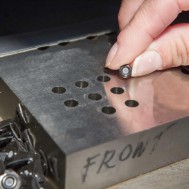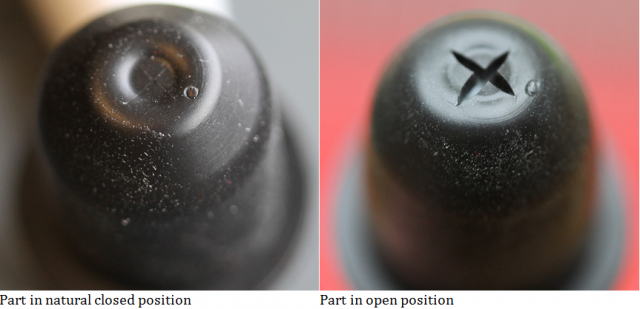We spoke with Project Engineer Dave Meehan as he broke down the process of Apple Rubber’s slitting and trimming.
Apple Blog: What is slitting?
Dave Meehan: Slitting is when a die cuts an opening in a rubber part after it’s molded; it’s a secondary operation meant to give parts different design functions.
It’s preferable to mold all features, but some features can’t be molded. A slit that is normally closed is an example of this.
In the part shown below, the opening was required to be closed when the part was in its natural state. Then it would open when there was a particular differential pressure.
AB: What are your current parts?
DM: A current slit application is a part for the air ride system for commercial trucks. The parts have a zero thickness opening, but have to be able to expel high pressure. As pressure builds up, the rubber part expands and expels pressure at the slit, then closes once the differential pressure is gone.
AB: How is it done?
DM: A die containing the required slit configuration is manufactured. The die is then installed in a punch press. The press closes on the rubber part, cutting the desired opening. In a relatively short amount of time, parts can be finished.
We don’t generally make the dies here, so there is a longer lead-time—it can add up to an extra three months. But if it is required, we can do it!
AB: So, what is trimming?
DM: Generally, when rubber is molded, there is flash — or extra material — at the fold, or parting line, where the plates meet. Trimming, or deflashing, removes that extra material.
Our most common way to remove flash is called cryogenic deflash. In that process, you take the part down to low temperature — near its glass transition point — and it gets brittle. It’s then tumbled in a machine, and the flash is removed.
Depending on part configuration and parting line requirements, this method can be more costly than die trimming. The cost of liquid nitrogen is high, and can give a higher overhead rate.
Also, for some parts, cryogenic deflash is not an option. An example is a filter seal. A filter seal is a rubber seal molded with a fabric or filter mesh. The cold temperature and harsh environment in a cryogenic deflash machine will destroy the filter membrane. In those cases, trimming is the best alternative. The die trimming process is simple. The die just comes down and cuts the edge of the part. It’s almost like a cookie cutter.
AB: What parts undergo the trimming process?
DM: Filter seals are the most common parts that we trim. With our advanced molding design, we can mold the filter seals in an array and trim the parts with the die punches. This allows for higher cavity counts in the molding operation, which helps reduce part cost. Die punching can also give a cleaner parting line.
AB: What are the set-up costs?
DM: The costs vary by complexity and number of cavities. There’s a trade-off with tooling. With a lower number of cavities there is a lower initial set-up cost, but the piece-prices will be higher because there is less capacity, and less throughput. Conversely, with more cavities, there may be more up-front cost, but yield a lower piece-price.
Thanks for your time, Dave!

